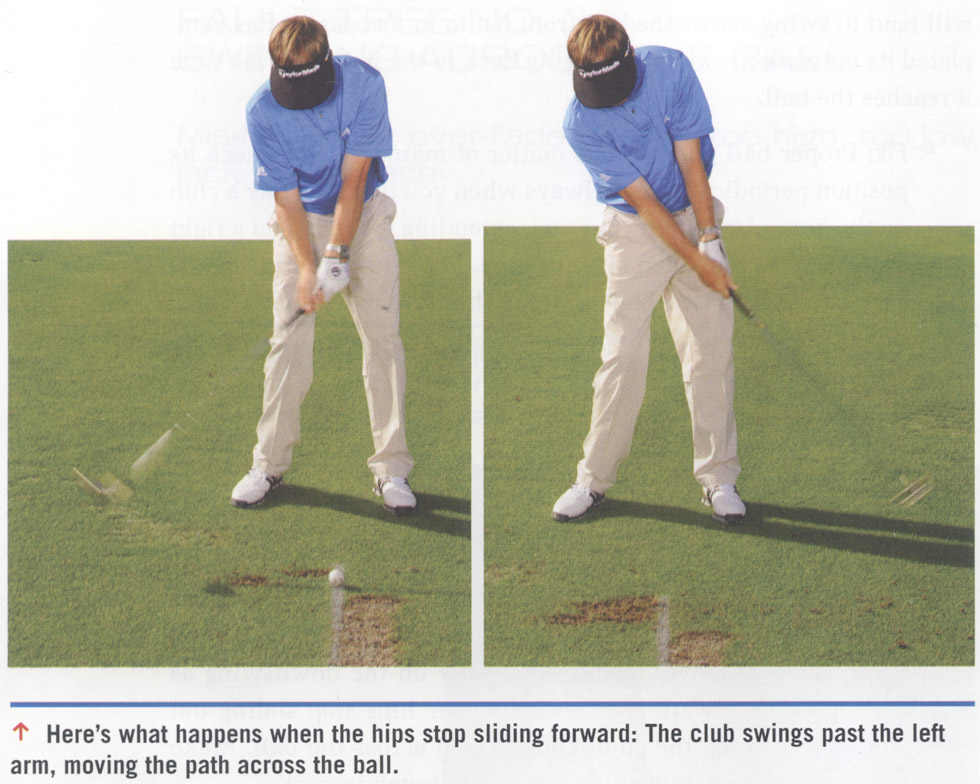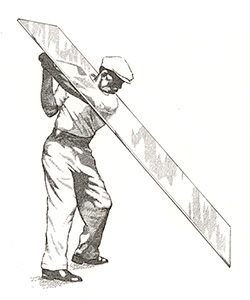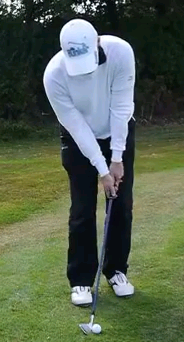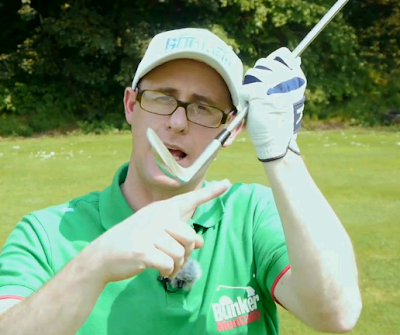In this section I will go more in depth on the Stack and Tilt golf swing from the previous section The Stack and Tilt Hybrid Golf Swing and Weight Shift. I suggest reading this section first, then slightly tweaking these ideas by following Sean Foley's advice because of how Stack and Tilt can stress you back more than Foley's "hybrid" version. Do not think that the ideas below are wrong in any way! Credit to AM Golf Associates LLC. The majority of the text below is from Michael Bennett and Andy Plummer's book: The Stack and Tilt Swing.
Introduction:
Most instruction today teaches moves that lead not only to a slice but also to hitting the ground behind the ball, which has inhibited the development of players and the game itself. Golfers are either learning the wrong things, or the right things in the wrong order. Why aren't their games improving? It boils down to no consensus on the basic physics of the game (such as what makes the ball go where it goes) and to no universal language for golfers to communicate the moves they're making or the shots they're hitting. Consequently they're forced to use vague cliches such as: "I swung too fast" or "I looked up." Thus Golfers become frustrated with the lack of direction, their games regression, or improvement that comes too slowly. See Adam Young's blog for more information on the learning curve: The Ups and Downs of Learning. Here's a quick snipet:

In this graph, the player started out with very low performance, but increased it by the
end of the session. But between session 1 and 2, some of the learning was lost/or the player
is not as warmed up at this point. They are still better than the day before, and have potential
to push the boundaries further today, as long as they practice with patience
and realistic expectations during the initial stages of the session.Remember, geometry and physics are the same for everyone; the anatomy of the individual player's body dictates the actual swing mechanics. We came to our conclusions and devised the system you're about to learn not just by studying how certain professionals hit the ball, but by applying the rules of science. Then we found evidence of these principles in the game's best players, past and present. Stack & Tilt keeps the body centered over the ball during the backswing and through the shot. There is no guesswork as to where the club will be at impact, no requirement to locate the ball through precise timing. With Stack & Tilt you simply favor your front foot at address and stay there throughout the swing, with no weight ever moving to your back foot. The first fundamental is hitting the ball solidly, and that comes primarily from controlling where your weight is during the swing. If your weight stays in place, contact is predictable; if your weight moves back and forth, it is not. This is the most important and most observable difference between the traditional swing and the Stack & Tilt. Swing technique varies greatly, even among the best players, but solid contact is the essential first ingredient. If you can learn to hit the ball solid consistently, you'll progress quickly. The goal is to develop a swing that hits the ball the longest, the straightest, the most often. We often hear that every golfer is different and, therefore, needs a different swing. We disagree, because the rules of geometry and physics are the same for all golfers, and it is the golfer's job to conform to them and to predict them.
Golf's Real Fundamentals:
From what has been mentioned in this blog and from what other instructors have mentioned around the golfing world, most if not all amateurs have the preconceptions that the fundamentals of golf are a complex plethora composed of: grip, stance, ball position, posture, alignment, tempo, "square at impact," etc. However if you look through the golf swings of the best that have ever played, you will find that there is no "correct" grip, stance, ball position, posture, alignment, and face to path numbers at impact because almost all of those great players: from Jack Nicklaus to Greg Norman to Ben Hogan to Arnold Palmer to Gary Player to Lee Trevino to Nancy Lopez to Annika Sorenstam, held the club in a non neutral manner, had a varying open or closed stance, had the ball positioned forward or backwards, had a "bad" rounded back or a "good" flat backed posture, and hit a push draw, a pull cut, a straight block, etc. So are all the fundamentals in this blog bogus? Well, I would say that although these "fundamentals" that I've posted on are not the industry standard by any means, these will give you a better chance of hitting the ball consistently solid and in a straight direction. Read Introduction and Understanding Ball Flight. The Stack and Tilt guys said it best: "The golf ball does not know if the player is fifteen or seventy-five years old, it does not know if you are fifty pounds overweight. All it knows is what the club tells it at impact."
The Stack and Tilt Fundamentals
1) hitting the ground in the same place every time
1) hitting the ground in the same place every time
2) having enough power to play the course
3) matching the clubface to the swing to control shot direction
Fundamental 1 - hitting the ground in the same place every time

We start many of our lessons by scratching a line in the ground and having the student straddle the line as if it were the ball, try to take divots on the target side of that line. Many students don't recognize that the low point is coming behind the ball. Second, once they see the problem, they don't know how to control it. The old cliches: "I got quick," "swung too fast," "came over it" aren't the most accurate terms to describe this inconsistency.
The first factor that contributes to the location of the low point is where the body weight is at impact. We measure the weight by locating the swing's two centers - the center of the shoulders (above the sternum) and the center of the hips or pelvis. If the swing's dynamic center, which is the combination of the shoulder and hip centers, is back too far, the swing tends to bottom out behind the ball. If the dynamic center is forward, the swing tends to bottom out in front of the ball.
The second factor is the width of the swing arc as controlled by the angles in the wrists and forward shaft lean (as seen from face-on view). Simply put, the more the shaft leans toward the target, the better chance the club will hit the ground farther forward, because the swing radius reaches its full length later. Conversely the more the shaft leans back, or away from the target, the longer the swing radius gets before it reaches the ball, and the farther behind the ball the club tends to hit the ground. Many average amateurs violate all of these principles and have to make compensations: ie: early extension, over the top, disconnection (chicken wings). They move the centers back too far off the ball and are not sophisticated enough to realize how forward and how fast they have to move them to make up for it. Also they unhinge the wrist early in an over the top move to get the low point somewhere near the ball.
Fundamental 2 - having enough power to play the course
The second fundamental that is common to good players is generating enough power, inslightly varying degrees, to play the course effectively.
The first power element is the path of the hands and the club moving inward - around the body as opposed to upward - on the backswing. Moving the hands and club on a circular arc conserves "angular momentum" http://en.wikipedia.org/wiki/Angular_momentum which is basically the rotational velocity around a particular axis (in golf - the spine). This dynamic is evident in many sports, ie: field-goal kickers in football - decades ago, field goals of thirty or forty yards were considered long, because kickers used a straight line approach. When that technique gave way to the soccer-style method of approaching the ball on an angle, allowing the torso to turn and the leg to swing in an arc, kickers started regularly making fifty-plus-yard field goals.


Approaching the ball on an angle generates much more power, allowing the torso to turn and leg to swing on an arc (conserving angular momentum).
Arms are more in and the club swings back on an arc!
The second factor in creating power is the spine angle changing from flexion (tilting forward to extension (straightening up) throughout the swing to create additional clubhead speed and launch. It is this principle that allows the golfer to use the ground as a springboard, much like a long jumper pushing off the runway.

Simply put, on the downswing the golfer should slide the hips toward the target and straighten the knees and the forward tilt of the body to catapult the shaft. This extension or elongation of the spine allows the golfer swing the club into the ball more powerful. For clarity, we tell many of our students to raise the belt (Straighten the knees) and tuck the butt under the upper body to finish (elongate the swing).
Compression into the ground on the backswing and start of downswing (while maintaining weight ratio on left and right foot). And then

the extension of the arms and legs into the ball while raising the belt and "jumping up" to an

upright, extended finish
Fundamental 3 - matching the clubface to the swing to control shot direction
Learn The Basic Form In 30 Minutes
The third fundamental is developing a predictable pattern of projecting the ball toward the target by controlling the clubface and the swing path. It is here the golfer uses the variables of grip, stanc, alignment, and so forth, in a familiar way to hit the ball as intended. The best players have mastered the first two fundamentals - low point and power - so direction control becomes the factor that determines success at the top levels of the game. On tour, where solid contact and power are prerequisites, the ability to control curve and trajectory creates wide gaps among players. Remember in understanding ball flight, the clubface gives the ball the initial direction while club path in relationship to that clubface gives the ball a tilted spin axis (resulting in hooks/ fades).
Working on these three fundamentals in order is the fastest way to develop your shot-making skills.
Learn The Basic Form In 30 Minutes
- With a middle iron, hit ten balls, focusing on keeping the weight on the front foot
- Hit the next ten balls with the weight forward and the left shoulder turning down on the backswing
- Hit the next ten balls with the weight forward, left shoulder down, and the hands swinging in
- Hit the next ten with the weight forward, shoulder down, hands in, and the butt tucking under the torso through impact
- Hit the next ten with the weight forward, shoulder down, hands in, butt tucked, and arms staying straight to the finish.
The New Tour Swing
How it works
We love it when a tour player comes up to us and says, "Hey, you're working with so-and-so. I saw him on the range doing this," and he mimics a backswing with the spine tilting way left. We love it because that's exactly what a good backswing should feel like.
The swing we teach looks different because the body never moves off the ball. Keeping your weight on your front foot is the simplest way to control where the club hits the ground, which is the first fundamental of hitting the ball. Golfers who shift to the right on the backswing have to make precisely the same shift back to the left by impact. That complicated maneuver is the biggest source of frustration in the game today.
Stack & Tilt relies less on timing. Golfers have long been taught that the body turns back level and the arms swing upright. The problem there is that if the arms lift off the rib cage going back, they have to get back on the body for the downswing so everything can moving together through impact. This blending of the horizontal turn and vertical arm swing is a difficult maneuver for most golfers. Stack & Tilt keeps the arms on the chest throughout the backswing and downswing, creating a flatter arm swing and much more repeatable motion.

Halfway Down
Weight moves left
The entire body starts the downswing together. More weight immediately moves to the left foot, with a distinct leaning into the left knee. Remember, the priority is to get the swing centers in front of the ball at impact. The hips start to turn back to level, and the legs reverse roles, the left leg straightening and the right leg flexing.
The turning body is supplying the initial acceleration, so the player must maximize rotational speed. The hips have limited turning capacity when they're tilted, so they have to come out of their tilt to keep accelerating. The move that releases the hips is a springing up of the lower body, where the butt muscles push the hips upward and toward the target. The player has to feel as if he's jumping up as the club comes down.
What It Feels Like
As you start down, imagine you're crushing a soda can under your left foot. The body has stayed centered on the backswing, so there's no need to shift back to the ball. This downward pressure on the left foot sets up the upward thrust of the hips through impact.

Impact
Lower body springs up
The upward thrust of the lower body that releases the hips—notice here the leg and butt muscles pushing forward—also helps deliver the club to the ball. Because the body is leaning on the front side, the club comes down steeply and will crash into the ground unless the swing shallows out. The pelvic thrust takes some of the steepness out of the swing.
The upper arms stay on the rib cage, and the hand path comes from well inside. The pelvic thrust allows the hips to keep turning, which keeps the clubface closing at a constant rate and the hands swinging on a circular arc. The club releases without any conscious hand or arm action. At impact, the swing centers are in front of the ball, so the club catches the ball first then cuts a divot.
What It Feels Like
Football kickers know they get more power if they swing their leg on an arc. Angular momentum (arc) beats linear force (straight line) for distance. Same goes here: The hands swing fastest when they approach from the inside.

Finish
Torso flexes forward
With the hips released toward the target, the torso flexes forward and the butt tucks under the back. Notice the spine tilts away from the target for the first time. The belt is level and several inches higher than it was at address.
As the torso stretches, the arms can extend and the hands don't drop over the left shoulder. The hips and shoulders have continued to turn toward the target. As the club re-cocks, forming a 90-degree angle with the forearms, the speed of the through-swing is absorbed. The hands are still swinging on a circular arc, because the body has kept up its speed. The so-called release is the body releasing from its forward tilt, not some manipulation by the hands and arms.
What It Feels Like
Ever notice the swing on the PGA Tour logo? That's the follow-through we teach: torso flexed forward, spine tilted back, arms extended. Forget about finishing with everything over your front leg, as many teachers say today.
Read More http://www.golfdigest.com/golf-instruction/2007-06/stackandtilt1_gd0706#ixzz2QSZcd0YF
































